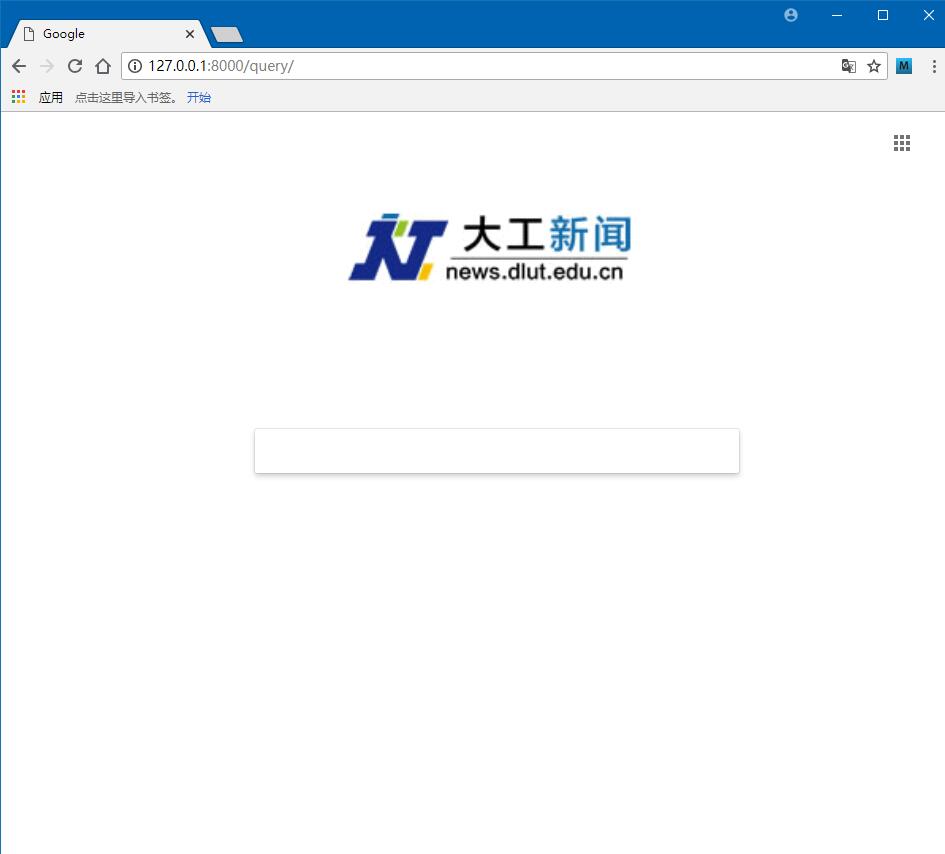使用python搭建小型搜索引擎
一、目标
为准备信息检索课程的期末大作业,因此我使用python搭建了一个小型的搜索引擎,其功能是检索大工新闻网的新闻。
二、原理和工具简介
2.1 原理
该搜索引擎的原理是采用scrapy对大工新闻网进行爬虫,提取出文字新闻,并将新闻内容存入数据库A,再利用Django框架搭建一个搜索服务器,在服务器上部署Haystack+Whoosh搜索引擎,使用jieba分词工具来进行中文分词和停用词过滤。通过搜索引擎工具建立索引文件后,在前端完成用户交互界面,实现一个完整的小型搜索引擎。
2.2 工具简介
Scrapy
Python开发的一个快速、高层次的屏幕抓取和web抓取框架,用于抓取web站点并从页面中提取结构化的数据。Scrapy用途广泛,可以用于数据挖掘、监测和自动化测试。
在本项目中用来爬取网站数据。
Django
Django是一个开放源代码的Web应用框架,由Python写成。采用了MVC的框架模式,即模型M,视图V和控制器C。
在本项目用来做搜索服务器的框架。
Haystack+Whoosh
Haystack是一个Django上的应用,可以用于整合搜索引擎,它只依赖于它自身的代码,利用它可以切换不同的搜索引擎工具。Whoosh是一个索引文本和搜索文本的类库,它可以提供搜索文本的服务。
在本项目中使用Haystack将Whoosh部署到Django服务器作为搜索引擎后端。
Jieba
Jieba是一个python实现的分词库,对中文有着很强大的分词能力。
在本项目用于对新闻进行中文分词和停用词过滤。
三、开发环境和运行环境
3.1 开发环境
3.2 运行环境
同开发环境
四、系统模块
4.1 网络爬虫模块
定义用于Scrapy爬虫的数据类型,包括链接、标题和文章内容:
1
2
3
4
class NewsItem(scrapy.Item):
url = scrapy.Field()
title = scrapy.Field()
content = scrapy.Field()
编写爬虫策略:
爬虫策略的制定依据于网页源代码的链接形式,由于要爬取的是文字类新闻,所以要跟进与文字类新闻的链接。对于具体的新闻页利用回调函数爬取其链接、标题和内容。而对于新闻列表页,需要跟进下一页的链接。具体规则代码如下:
1
2
3
4
5
6
7
8
9
10
11
12
13
14
15
16
17
18
19
20
21
22
class NewsSpider(CrawlSpider):
print("news spider starting")
name = 'news'
allowed_domains = ['news.dlut.edu.cn']
start_urls = ['http://news.dlut.edu.cn/']
rules = (
# 对于新闻页链接进行跟进
Rule(LinkExtractor(allow=("xw/[a-z]+.htm"))),
# 对于详细新闻页利用parse_item回调函数进行内容爬取
Rule(LinkExtractor(allow=("info/\d{4,}/\d{3,}\.htm")),callback="parse_item"),
# 对于新闻列表中的下一页链接进行跟进
Rule(LinkExtractor(allow=("\d{1,}.htm"),restrict_xpaths="//a[@class='Next']")),
)
def parse_item(self, response):
self.log("Hi, this is a new page! %s"% response.url)
item = NewsItem()
item['title'] = response.xpath('/html/head/title/text()').extract()[0]
item['url'] = response.url
item['content']=response.xpath("//div[@class='cont-detail fs-small']/p/text()").extract()
yield item
使用pipline机制将数据保存至数据库当中
1
2
3
4
5
6
7
8
9
10
11
12
13
14
15
16
17
18
19
20
21
22
23
24
25
26
27
28
29
class SpiderprojectPipeline(object):
def process_item(self, item, spider):
if spider.name == 'news':
conn = sqlite3.connect('db.sqlite3')
cursor = conn.cursor()
title = item['title']
url = item['url']
content_tmp = item['content']
content=""
for p in content_tmp:
content+=p.strip()
sql_search = 'select arturl from search_article where arturl=="%s"' % (url)
sql = 'insert into articles_article(title, content, arturl) values("%s", "%s", "%s")'%(title, content, url)
try:
#如果当前数据库中不存在该条新闻,则将新闻保存至数据库当中
cursor.execute(sql_search)
result_search = cursor.fetchone()
if result_search is None or result_search[0].strip()=='':
cursor.execute(sql)
result=cursor.fetchone()
conn.commit()
cursor.execute(sql)
result=cursor.fetchone()
conn.commit()
except Exception as e:
print(">>> catch exception !")
print(e)
conn.rollback()
return item
4.2 搜索模块
在要进行搜索的应用的models.py文件中建立model类用来表示要进行搜索的新闻文章
1
2
3
4
class Article(models.Model):
title = models.CharField(max_length=50)
arturl = models.CharField(max_length=200)
content = models.CharField(max_length=1000)
同时使用django命令python manage.py makemigrations和python manage.py migrate生成数据库文件,并用爬虫得到的数据库替换生成的数据库。
在django框架中配置Haystack+Whoosh来引入搜索模块
1
2
3
4
5
6
7
8
9
10
11
12
# 配置搜索引擎后端
HAYSTACK_CONNECTIONS={
'default':{
'ENGINE': 'articles.whoosh_cn_backend.WhooshEngine',
# 索引文件路径
'PATH': os.path.join(BASE_DIR, 'whoosh_index'), # 在项目目录下创建文件夹 whoosh_index
}
}
# 当添加、修改、删除数据时,自动生成索引
HAYSTACK_SIGNAL_PROCESSOR = 'haystack.signals.RealtimeSignalProcessor'
# 每页显示十条搜索结果
HAYSTACK_SEARCH_RESULTS_PER_PAGE = 10
在要进行搜索的应用的目录下建立search_indexes.py文件
1
2
3
4
5
6
7
8
9
10
11
12
from haystack import indexes
from articles.models import Article
class ArticleIndex(indexes.SearchIndex, indexes.Indexable): #类名必须为需要检索的Model_name+Index,这里需要检索Article,所以创建ArticleIndex
text = indexes.CharField(document=True, use_template=True) #创建一个text字段
def get_model(self): #重载get_model方法,必须要有!
return Article
def index_queryset(self, using=None): #重载index_..函数
"""Used when the entire index for model is updated."""
return self.get_model().objects.all()
在articles\templates\search\indexes\articles\下建立article_text.txt文件确定搜索内容
1
2
3
{{ object.title }}
{{ object.content }}
{{ object.url }}
4.2 预处理模块
使用jieba来进行中文分词,需要在whoosh_cn_backend文件中替换StemmingAnalyzer为ChineseAnalyzer
同时引入停用词表,配置ChineseAnalyzer使其支持停用词过滤
1
2
3
4
5
6
7
8
9
10
11
12
13
14
15
16
17
18
19
20
21
22
23
24
25
26
import jieba
import re
import os
# 导入停用词过滤表
stop_file_dir=os.path.dirname(os.path.dirname(os.path.abspath(__file__)))
STOP_WORDS = frozenset([line.strip() for line in open(os.path.join(stop_file_dir, 'stop.txt'),'r',encoding='gbk').readlines()])
accepted_chars = re.compile(r"[\u4E00-\u9FD5]+")
class ChineseTokenizer(Tokenizer):
def __call__(self, text, **kargs):
words = jieba.tokenize(text, mode="search")
token = Token()
for (w, start_pos, stop_pos) in words:
if not accepted_chars.match(w) and len(w) <= 1:
continue
token.original = token.text = w
token.pos = start_pos
token.startchar = start_pos
token.endchar = stop_pos
yield token
def ChineseAnalyzer(stoplist=STOP_WORDS, minsize=1, stemfn=stem, cachesize=50000):
return (ChineseTokenizer() | LowercaseFilter() |
StopFilter(stoplist=stoplist, minsize=minsize) |
StemFilter(stemfn=stemfn, ignore=None, cachesize=cachesize))
配置完成后使用python manage.py rebuild_index建立搜索索引
4.4 交互模块
搜索首页html关键代码:
1
2
3
4
5
<form method='get' action="/search/" target="_blank">
<input type="text" name="q">
<br>
<input type="submit" value="查询">
</form>
首页如下图所示:
查询结果页html关键代码:
1 | {% load highlight %} |
其中使用
1 | {% load highlight %} |
进行搜索结果的高亮显示
最终搜索页面如下图所示:
